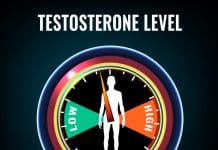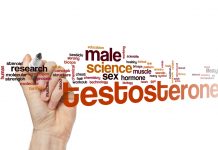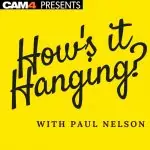VIDEO TRANSCRIPT:
Hormones change as we age. As you can tell, these are different hormones: estrogen, thyroid, progesterone, insulin, testosterone, cortisol, growth hormone, and this is not only male related but also females. Most hormones, as you can tell, go down with age, except insulin and cortisol. Insulin, we become more and more insulin resistant, and our cortisol, which is an inflammatory hormone and stress hormone also increases. Those two trends of increasing insulin and cortisol also make us gain more weight, more fat, get more inflammation and more chronic illness that are related to aging.
Today, I’m only going to focus on one of them, testosterone. Eventually, I will have a lecture on each one of these hormones for you guys to watch, so stay tuned.
Next one. So, testosterone, the target organs. Testosterone is an androgenic hormone. The world, when you say testosterone, equates a hormone to males and the fact is that not only men have it but also women. Women have it at a tenth of a concentration that men have in your bloodstream, but the target organs are pretty much common except obviously for the penile organ. When it comes to the effects of testosterone, it has effects on hair growth, balding, sebum production that sometimes causes acne, liver actually, it improves, promotes, the synthesis of proteins in the liver. When it comes to male sexual organs, it’s responsible for penile growth, spermatogenesis, which is the production of sperm, prostate growth, and function. In the brain, it affects libido and mood. In the muscle, it increases strength and muscle volume. In the kidneys, it stimulates the production, I’m sorry, there is a misspelling there, stimulates the production of red blood cells. In the bone marrow, it stimulates of stem cells. In bone, it accelerates the linear growth in growing boys and girls. It is also obviously associated with bone density.
What are the effects of having low testosterone? I’ll go through different slides and coming up on explaining what low testosterone means and the ranges, et cetera. But one of the effects is sexual dysfunction or lack of interest in sex, some erectile dysfunction, decrease of sense of well being, increase irritation or moodiness, decrease red blood cells to the point that somebody can become anemic, decrease bone marrow density, decrease lean body mass, muscle strength and increase in fat mass. As you can tell, all of them could be associated with aging, but the fact is that normalizing testosterone blood levels can reverse most of these effects.
This is where most of the controversy and discussion occurs, even in 2018, when it comes to defining what’s normal testosterone, where are the normal ranges. Believe it or not, it not only depends on the guidelines, committees and medical groups but also on the different lab companies, like Lap Core and Quest and other lab companies have different ranges. They gather that data from their database on the spread of testosterone and in men that are using, and women, that use their companies.
In general, it’s probably safe to say that the total testosterone, and I’ll explain what that means, total and free testosterone just coming up, they range anywhere from 350 to 1100 in men and from 10 to 50 nanograms per deciliter for women. By the way, this nanograms per liter for people watching the webinar from outside the United States, the units are different. I usually talk about micromoles per liter or other units like that. So, I apologize for that. But these are units used in the States.
The symptoms of low testosterone, as I said, fatigue, low or lack of sex drive, poor appetite, loss of muscle mass and strength, depression and others.
The effect of age on testosterone. Age-related decline begins around 30 to 40 years of age, and approximately 1.2% of testosterone is lost every year, and obviously, that loss can be accelerated by different factors that I’ll be covering soon. The average testosterone of men 75 years of age compared to a younger man of 25 years of age total is about 35% in bioavailable. I’ll speak about what bioavailable means, is 50%.
However, many men in the seventh or eighth decade have normal testosterone levels. So, this is not 100% of rule for everybody. Some men are healthy enough or lucky enough not to have testosterone deficiency when they’re older. Excuse me.
Also, something that we forget sometimes is that the circadian rhythm actually promotes the production of most hormones at night, and the testosterone peaks early in the morning, around 4:00 to 6:00 AM, and it peaks both in older men and younger men. As you can in this graph, the younger men have higher levels and higher peak. The effects are blunted by age. So, you can tell in the older men, there is not as much of a peak and is more of a constant blood level throughout the day, and that happens in most aging men.
What is the testosterone level defined as low? This is another point of controversy and discussion. I don’t think we’re ever going to have groups, medical groups agree, although we’re getting closer as you can tell on this table, but these are different medical groups, European Academy of Urology, the European Association of Urology, International Society of [inaudible 00:08:25], the International Society for the Study of the Aging Male, and the Endocrine Society. The first three agree, and that was the guidelines of 2009 that anything under 350 nanograms per deciliter or for guys outside the United States is 12.1 nanomoles per liter, and free testosterone less than 65 picograms per milliliters.
The TES, which is an endocrine society, I think they just posted new guidelines, but it’s more or less the same value, 300. The disagreement here, too. On the Europeans 350 and believe it or not, there is a group of experts that got together in 2014, it’s the high prescribers, doctors have a lot of experience that agreed that anything under 400 nanograms is considered low.
There’s no agreement. Insurance companies vary, too, when it comes to approval of testosterone therapies. Most of them are going now by 300 to 350. You also have to have the symptoms and the lab test that proves that. For clinics that do not take insurance, cash-based clinics, they tend to be a little bit more flexible when it comes to testosterone blood levels, up to 500 nanograms if you have symptoms of low testosterone. It depends obviously whether or not you’re going to be getting products that are paid by your insurance company or if you’re going to be using, or instance, a compounding pharmacy. I’ll be explaining what compounding pharmacies do and what different changes in the industry are as we speak.
I also reviewed a few studies. I didn’t write the references here because there are too many, but you can go to excelmale.com. I have this information and references. But these are different studies that have linked different levels of testosterone and risks of different pathologies or diseases or issues or health issues. Less than 450, the study linked that to a risk of the increased metabolic syndrome, which is an increase in fat mass, waist circumstance, low HDL, hydro glycerides, et cetera.
Less than 400 in another study linked to venous leakage, which is internal penile damage that affects erectile function. Less than 350, a study linked that to increased death risk and anemia risk. Less than 300, lower libido, weight gain, and diabetes risk increased. Less than 300 increase risk of fractures, memory related issues and depression, risk increases. Less than 250 in another study, increase arterial plaque and decreased sleep quality. Less than 235 in another study, hardening of the arteries and less than 200, a decrease in morning erections. Less than 150, increase inflammation.
As you can tell, 300 or so, 350, 300, it’s kind of a midpoint in all this data. It makes sense so far. What the guidelines have been saying is not far off from what studies are showing when it comes to increased risks of different health issues.
















